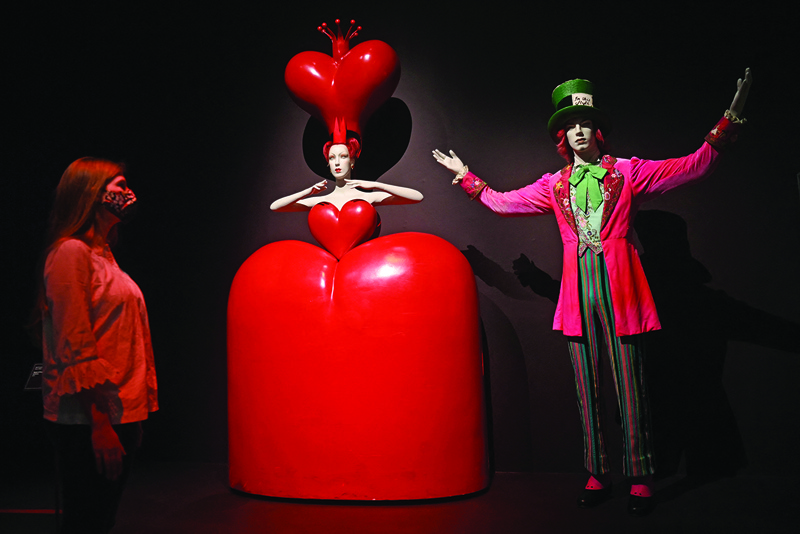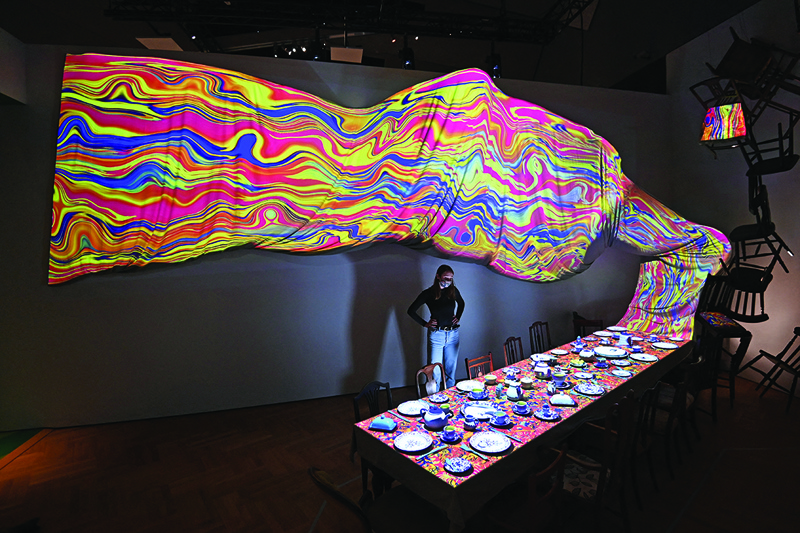 A museum employee poses next to a costume entitled (left) ‘Queen of Hearts costume‘ and ‘Costume for the Mad Hatter’ 2010 by artist Bob Crowley during a press preview of the exhibition Alice: Curiouser and Curiouser at the Victoria & Albert museum in London. — AFP photos
A museum employee poses next to a costume entitled (left) ‘Queen of Hearts costume‘ and ‘Costume for the Mad Hatter’ 2010 by artist Bob Crowley during a press preview of the exhibition Alice: Curiouser and Curiouser at the Victoria & Albert museum in London. — AFP photos
After a year of the coronavirus pandemic's mind-bending assault on normal life, London's Victoria & Albert Museum reopens this week, taking visitors down another rabbit hole. "Alice: Curiouser and Curiouser" explores the global impact of "Alice's Adventures in Wonderland", Lewis Carroll's classic 1865 novel, and its enduring appeal to artists. The exhibition opens to the public on Saturday, and plunges visitors, like Alice, straight down a rabbit hole-the museum stairs-with a jumble of signs in every direction. As they emerge from the V&A's dimly lit basement, guests are immersed in theatrical costumes, film extracts, manuscripts and drawings.
The installations combine sound and visual effects, "to explore the origins, adaptations and reinventions" of the work first imagined by Carroll, an Oxford mathematician whose real name was Charles Lutwidge Dodgson. Each section of the exhibition, which is meant to appeal to visitors of all ages, has its own distinct look. Guests walk across a Victorian beachfront, reminiscent of the time Carroll himself was writing, and encounter scenes from the book: the murderous Queen of Hearts' rose garden and the Mad Hatter's tea party with the March Hare.
 A museum employee poses next to an artwork entitled ‘Reimagining the Tea-Party’ by artist Heston Blumenthal and David McKean.
A museum employee poses next to an artwork entitled ‘Reimagining the Tea-Party’ by artist Heston Blumenthal and David McKean.
'Everything is upside down'
Museums were allowed to reopen their doors on Monday after months of restrictions to curb the spread of coronavirus which has claimed nearly 128,000 lives across Britain. At the V&A in west London, as elsewhere, social distancing, hand sanitizer and facemasks are the order of the day for the reopening. Interactive booths, like those where visitors can play virtual reality croquet against the Queen of Hearts, are cleaned regularly. The Alice exhibition was originally planned to open in June 2020, but its opening now-nearly a year later-is fitting, said assistant curator Harriet Reed.
"We are so thrilled that we can bump this back in and enjoy the exhibition safely, and share it with the world," she told AFP. "I think we're all feeling a little bit tired, a little bit jaded, a little bit uninspired maybe," she said, suggesting Alice's world could offer a restorative "boost of optimism". Reed said in the face of the pandemic, everyone can learn from Alice's "amazing determination, bravery" and the way she "stands up for what she believes in". "We definitely feel like we live in a crazy wonderland right now. Everything is upside down," she said. "I think we can really relate to that sense of complete displacement right now."
'Strong minded heroine'
The exhibition, which is divided into five parts, first looks at the novel's Victorian-era influences before moving on to its film adaptations. Excerpts from the Walt Disney film "Alice in Wonderland" (1951) and Tim Burton's 2010 remake are displayed alongside the first silent film to portray Alice and even a Japanese anime inspired by her story. A later section focuses on the influence of "Alice's Adventures in Wonderland" on surrealism and the 1960s.
An original edition of the book illustrated by the Spanish artist Salvador Dali is showcased with theatre and ballet adaptations. The final installations contend with the "contemporary fascination" with the children's book over a century and a half after it was first published. The exhibition, Reed says, attempts to answer a question that is "almost unanswerable" and show why Carroll's characters continue to inspire well into the 21st century.
"I think a lot of it has to do with having a very strong-minded heroine", she added. Her favorite item in the exhibition was the program for a play performed by the suffragette campaigners, showing Alice agitating for the right to vote. "Alice is the symbol of empowerment and female agency that was really exciting for us," she said. - AFP
.jpg)



